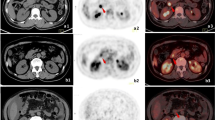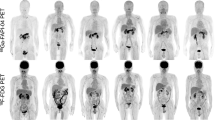Abstract
Purpose
To determine the optimal imaging tool for clinical evaluation of pancreatic neoplasm by comparing the performance of 18F-FDG PET/MRI and PET/CT.
Procedures
Patients with suspected pancreatic neoplasms underwent PET/MRI and PET/CT in the same day prior to resection or endoscopic ultrasound-guided fine-needle aspiration. Histology served as the golden standard of lesion classification. Visual assessment on lesion type and lesion malignancy via PET/MRI and PET/CT images was compared. Standard uptake values (SUVs) of PET images from the two scanners were measured and their correlations were further evaluated.
Results
Thirty-nine patients were included for the final analysis. In visual assessment, we found MRI achieved better performance than CT in differentiating solid and cystic neoplasms, with accuracy of 100% vs. 87%, respectively. In visual malignancy diagnosis, the accuracy of PET/CT was 92.3% for overall lesions and 90.9% for cysts, while the accuracy of PET/MRI was 92.3% and 86.4%, respectively. Besides, semi-quantitative analysis achieved better specificity than visual assessment for both hybrid modalities (100% vs. 87.5% for PET/CT; 100% vs. 81.5% for PET/MR). Furthermore, strong correlation of SUV was found between PET/CT and PET/MRI, with Pearson’s correlation coefficients > 0.82.
Conclusions
In this study, we found PET/MRI and PET/CT, both using 18F-FDG as tracer, had comparable overall performance in identification of pancreatic neoplasms. Interestingly, for patients who had suspected pancreatic neoplasm but invisible FDG uptake, PET/MRI had shown exceptionally better performance, probably because MR images could detect tiny abnormal structures to improve diagnosis.




Similar content being viewed by others
References
Yabar CS, Winter JM (2016) Pancreatic cancer: a review. Gastroenterology Clinics of North America 45:429-+.
McAllister F, Montiel MF, Uberoi GS, Uberoi AS, Maitra A, Bhutani MS (2017) Current status and future directions for screening patients at high risk for pancreatic cancer. Gastroenterol Hepatol 13:268–275
He J, Chen W (2012) Chinese cancer registry annual report 2012. Beijing: Press of Military Medical Sciences:68–71
Singhi AD, Koay EJ, Chari ST, Maitra A (2019) Early detection of pancreatic cancer: opportunities and challenges. Gastroenterology 156:2024–2040
Guarneri G, Gasparini G, Crippa S, Andreasi V, Falconi M (2019) Diagnostic strategy with a solid pancreatic mass. Presse Medicale 48:E125–E145
Farrell JJ (2015) Prevalence, diagnosis and management of pancreatic cystic neoplasms: current status and future directions. Gut and Liver 9:571–589
Sharib JM, Fonseca AL, Swords DS et al (2018) Surgical overtreatment of pancreatic intraductal papillary mucinous neoplasms: do the 2017 International Consensus Guidelines improve clinical decision making? Surgery 164:1178–1184
Barreto SG, Sirohi B (2019) Is it time to reconsider the principles of pancreatic cancer surgery? Pancreatology 19:204–205
Pietryga JA, Morgan DE (2015) Imaging preoperatively for pancreatic adenocarcinoma. J Gastrointest Oncol 6:343–357
Driedger MR, Dixon E, Mohamed R, Sutherland FR, Bathe OF, Ball CG (2015) The diagnostic pathway for solid pancreatic neoplasms: are we applying too many tests? J Surg Res 199:39–43
Jang KM, Kim SH, Min JH et al (2014) Value of diffusion-weighted MRI for differentiating malignant from benign intraductal papillary mucinous neoplasms of the pancreas. Am J Roentgenol 203:992–1000
Hayano K, Miura F, Amano H et al (2013) Correlation of apparent diffusion coefficient measured by diffusion-weighted MRI and clinicopathologic features in pancreatic cancer patients. J Hepatobiliary Pancreat Sci 20:243–248
Chang J, Schomer D, Dragovich T (2015) Anatomical, physiological, and molecular imaging for pancreatic cancer: current clinical use and future implications. Biomed Res Int 2015
Dang H, Wang R, Liu J, Lin M, Feng X, Xu B (2020) Positron emission tomography/magnetic resonance imaging for the diagnosis and differentiation of pancreatic tumors. Nucl Med Commun 41:155–161
Drzezga A, Souvatzoglou M, Eiber M et al (2012) First clinical experience with integrated whole-body PET/MR: comparison to PET/CT in patients with oncologic diagnoses. J Nucl Med 53:845–855
Martin O, Schaarschmidt BM, Kirchner J et al (2020) PET/MRI versus PET/CT for whole-body staging: results from a single-center observational study on 1,003 sequential examinations. J Nucl Med 61:1131–1136
Chen B-B, Tien Y-W, Chang M-C et al (2016) PET/MRI in pancreatic and periampullary cancer: correlating diffusion-weighted imaging, MR spectroscopy and glucose metabolic activity with clinical stage and prognosis. Eur J Nucl Med Mol Imaging 43:1753–1764
Joo I, Lee JM, Lee DH et al (2017) Preoperative assessment of pancreatic cancer with FDG PET/MR imaging versus FDG PET/CT pus contrast-enhanced multidetector CT: a prospective preliminary study. Radiology 282:149–159
Tanaka M, Chari S, Adsay V et al (2006) International consensus guidelines for management of intraductal papillary mucinous neoplasms and mucinous cystic neoplasms of the pancreas[J]. Pancreatology 6(1–2):17–32
Adams Michael C, Turkington Timothy G, Wilson Joshua M, et al. (2010) A systematic review of the factors affecting accuracy of SUV measurements.[J]. AJR. Am J Roentgenol 195(2):310–320
Sun Yiwen, Qiao Xiangmei, Jiang Chong, et al. (2020) Texture analysis improves the value of pretreatment 18F-FDG PET/CT in predicting interim response of primary gastrointestinal diffuse large B-cell lymphoma.[J]. Contrast Media Mol Imaging
Kinahan PE, Fletcher JW (2010) Positron emission tomography-computed tomography standardized uptake values in clinical practice and assessing response to therapy[J]. Seminars in Ultrasound, CT, and MRI 31(6):496–505
Lowe VJ, DeLong DM, Hoffman JM et al (1995) Optimum scanning protocol for FDG-PET evaluation of pulmonary malignancy [J]. J Nucl Med 36(5):883–887
Nagamachi S, Nishii R, Wakamatsu H et al (2013) The usefulness of F-18-FDG PET/MRI fusion image in diagnosing pancreatic tumor: comparison with F-18-FDG PET/CT. Ann Nucl Med 27:554–563
Ruf J, Haenninen EL, Boehmig M et al (2006) Impact of FDG-PET/MRI image fusion on the detection of pancreatic cancer. Pancreatology 6:512–519
Rosenkrantz AB, Friedman K, Chandarana H et al (2016) Current status of hybrid PET/MRI in oncologic imaging. Am J Roentgenol 206:162–172
Funding
This work was sponsored in part by the National Key Research and Development Program of China (No. 2020YFC2002702), the National Natural Science Foundation of China (No. 82071967), CAMS initiative for innovative medicine (No. 2016ZX310174-4), and Capital’s Funds for Health Improvement and Research (No. CFH-2018–2-4014).
Author information
Authors and Affiliations
Corresponding author
Ethics declarations
Conflict of Interest
The authors declare that they have no conflict of interest.
Additional information
Publisher's Note
Springer Nature remains neutral with regard to jurisdictional claims in published maps and institutional affiliations.
Rights and permissions
About this article
Cite this article
Xing, H., Ding, H., Hou, B. et al. The Performance Comparison of 18F-FDG PET/MRI and 18F-FDG PET/CT for the Identification of Pancreatic Neoplasms. Mol Imaging Biol 24, 489–497 (2022). https://doi.org/10.1007/s11307-021-01687-w
Received:
Revised:
Accepted:
Published:
Issue Date:
DOI: https://doi.org/10.1007/s11307-021-01687-w




